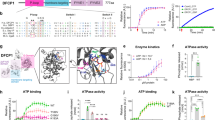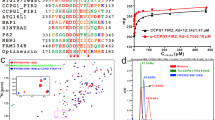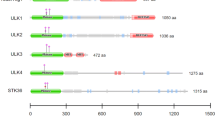Abstract
Autophagy is a finely orchestrated cellular catabolic process that requires multiple autophagy-related gene products (ATG proteins). The ULK1 complex functions to integrate upstream signals to downstream ATG proteins through an unknown mechanism. Here we have identified an interaction between mammalian FIP200 and ATG16L1, essential components of the ULK1 and ATG5 complexes, respectively. Further analyses show this is a direct interaction mediated by a short domain of ATG16L1 that we term the FIP200-binding domain (FBD). The FBD is not required for ATG16L1 self-dimerization or interaction with ATG5. Notably, an FBD-deleted ATG16L1 mutant is defective in mediating amino acid starvation–induced autophagy, which requires the ULK1 complex. However, this mutant retains its function in supporting glucose deprivation–induced autophagy, a ULK1 complex–independent process. This study therefore identifies a previously uncharacterized interaction between the ULK1 and ATG5 complexes that can distinguish ULK1-dependent and -independent autophagy processes.
This is a preview of subscription content, access via your institution
Access options
Subscribe to this journal
Receive 12 print issues and online access
$189.00 per year
only $15.75 per issue
Buy this article
- Purchase on Springer Link
- Instant access to full article PDF
Prices may be subject to local taxes which are calculated during checkout






Similar content being viewed by others
Change history
13 January 2013
In the version of this article initially published online, grant number RO1CA166413 was not acknowledged. The error has been corrected for the print, PDF and HTML versions of this article.
References
Ciechanover, A. Proteolysis: from the lysosome to ubiquitin and the proteasome. Nat. Rev. Mol. Cell Biol. 6, 79–87 (2005).
Wirawan, E., Vanden Berghe, T., Lippens, S., Agostinis, P. & Vandenabeele, P. Autophagy: for better or for worse. Cell Res. 22, 43–61 (2012).
Levine, B. & Kroemer, G. Autophagy in the pathogenesis of disease. Cell 132, 27–42 (2008).
Geng, J. & Klionsky, D.J. The Atg8 and Atg12 ubiquitin-like conjugation systems in macroautophagy. 'Protein modifications: beyond the usual suspects' review series. EMBO Rep. 9, 859–864 (2008).
Bjørkøy, G. et al. p62/SQSTM1 forms protein aggregates degraded by autophagy and has a protective effect on huntingtin-induced cell death. J. Cell Biol. 171, 603–614 (2005).
Pankiv, S. et al. p62/SQSTM1 binds directly to Atg8/LC3 to facilitate degradation of ubiquitinated protein aggregates by autophagy. J. Biol. Chem. 282, 24131–24145 (2007).
Kraft, C., Peter, M. & Hofmann, K. Selective autophagy: ubiquitin-mediated recognition and beyond. Nat. Cell Biol. 12, 836–841 (2010).
Nemoto, T. et al. The mouse APG10 homologue, an E2-like enzyme for Apg12p conjugation, facilitates MAP-LC3 modification. J. Biol. Chem. 278, 39517–39526 (2003).
Fujita, N. et al. The Atg16L complex specifies the site of LC3 lipidation for membrane biogenesis in autophagy. Mol. Biol. Cell 19, 2092–2100 (2008).
Saitoh, T. et al. Loss of the autophagy protein Atg16L1 enhances endotoxin-induced IL-1β production. Nature 456, 264–268 (2008).
Mizushima, N. et al. Dissection of autophagosome formation using Apg5-deficient mouse embryonic stem cells. J. Cell Biol. 152, 657–668 (2001).
Komatsu, M. et al. Impairment of starvation-induced and constitutive autophagy in Atg7-deficient mice. J. Cell Biol. 169, 425–434 (2005).
Sou, Y.S. et al. The Atg8 conjugation system is indispensable for proper development of autophagic isolation membranes in mice. Mol. Biol. Cell 19, 4762–4775 (2008).
Florey, O., Kim, S.E., Sandoval, C.P., Haynes, C.M. & Overholtzer, M. Autophagy machinery mediates macroendocytic processing and entotic cell death by targeting single membranes. Nat. Cell Biol. 13, 1335–1343 (2011).
Martinez, J. et al. Microtubule-associated protein 1 light chain 3 alpha (LC3)-associated phagocytosis is required for the efficient clearance of dead cells. Proc. Natl. Acad. Sci. USA 108, 17396–17401 (2011).
Florey, O. & Overholtzer, M. Autophagy proteins in macroendocytic engulfment. Trends Cell Biol. 22, 374–380 (2012).
Itakura, E., Kishi, C., Inoue, K. & Mizushima, N. Beclin 1 forms two distinct phosphatidylinositol 3-kinase complexes with mammalian Atg14 and UVRAG. Mol. Biol. Cell 19, 5360–5372 (2008).
Zhong, Y. et al. Distinct regulation of autophagic activity by Atg14L and Rubicon associated with Beclin 1-phosphatidylinositol-3-kinase complex. Nat. Cell Biol. 11, 468–476 (2009).
Ganley, I.G. et al. ULK1.ATG13.FIP200 complex mediates mTOR signaling and is essential for autophagy. J. Biol. Chem. 284, 12297–12305 (2009).
Jung, C.H. et al. ULK-Atg13–FIP200 complexes mediate mTOR signaling to the autophagy machinery. Mol. Biol. Cell 20, 1992–2003 (2009).
Itakura, E. & Mizushima, N. Characterization of autophagosome formation site by a hierarchical analysis of mammalian Atg proteins. Autophagy 6, 764–776 (2010).
Hara, T. et al. FIP200, a ULK-interacting protein, is required for autophagosome formation in mammalian cells. J. Cell Biol. 181, 497–510 (2008).
Mizushima, N. et al. Mouse Apg16L, a novel WD-repeat protein, targets to the autophagic isolation membrane with the Apg12-Apg5 conjugate. J. Cell Sci. 116, 1679–1688 (2003).
Fujioka, Y., Noda, N.N., Nakatogawa, H., Ohsumi, Y. & Inagaki, F. Dimeric coiled-coil structure of Saccharomyces cerevisiae Atg16 and its functional significance in autophagy. J. Biol. Chem. 285, 1508–1515 (2010).
Matsushita, M. et al. Structure of Atg5Atg16, a complex essential for autophagy. J. Biol. Chem. 282, 6763–6772 (2007).
Ishibashi, K. et al. Atg16L2, a novel isoform of mammalian Atg16L that is not essential for canonical autophagy despite forming an Atg12–5-16L2 complex. Autophagy 7, 1500–1513 (2011).
Cheong, H., Lindsten, T., Wu, J., Lu, C. & Thompson, C.B. Ammonia-induced autophagy is independent of ULK1/ULK2 kinases. Proc. Natl. Acad. Sci. USA 108, 11121–11126 (2011).
Eng, C.H., Yu, K., Lucas, J., White, E. & Abraham, R.T. Ammonia derived from glutaminolysis is a diffusible regulator of autophagy. Sci. Signal. 3, ra31 (2010).
Shang, L. et al. Nutrient starvation elicits an acute autophagic response mediated by Ulk1 dephosphorylation and its subsequent dissociation from AMPK. Proc. Natl. Acad. Sci. USA 108, 4788–4793 (2011).
Alers, S. et al. Atg13 and FIP200 act independently of Ulk1 and Ulk2 in autophagy induction. Autophagy 7, 1423–1433 (2011).
Kundu, M. et al. Ulk1 plays a critical role in the autophagic clearance of mitochondria and ribosomes during reticulocyte maturation. Blood 112, 1493–1502 (2008).
Wei, H. et al. Suppression of autophagy by FIP200 deletion inhibits mammary tumorigenesis. Genes Dev. 25, 1510–1527 (2011).
Fujita, N. et al. Differential involvement of Atg16L1 in Crohn disease and canonical autophagy: analysis of the organization of the Atg16L1 complex in fibroblasts. J. Biol. Chem. 284, 32602–32609 (2009).
Rioux, J.D. et al. Genome-wide association study identifies new susceptibility loci for Crohn disease and implicates autophagy in disease pathogenesis. Nat. Genet. 39, 596–604 (2007).
Hampe, J. et al. A genome-wide association scan of nonsynonymous SNPs identifies a susceptibility variant for Crohn disease in ATG16L1. Nat. Genet. 39, 207–211 (2007).
Hanada, T. et al. The Atg12-Atg5 conjugate has a novel E3-like activity for protein lipidation in autophagy. J. Biol. Chem. 282, 37298–37302 (2007).
Gao, Z. et al. Processing of autophagic protein LC3 by the 20S proteasome. Autophagy 6, 126–137 (2010).
Shao, Y., Gao, Z., Feldman, T. & Jiang, X. Stimulation of ATG12-ATG5 conjugation by ribonucleic acid. Autophagy 3, 10–16 (2007).
Acknowledgements
We thank S. Akira (Osaka University) for Atg16l1−/− MEFs, M. Komatsu (Tokyo Metropolitan Institute of Medical Science) for Atg3−/− MEFs, N. Mizushima (Tokyo Medical and Dental University) for Atg5−/− MEFs, C. Thompson (Memorial Sloan Kettering Cancer Center, MSKCC) for ULK1 and ULK2 double-knockout MEFs, F. Giancotti (MSKCC) for β-integrin–specific antibody and H. Erdjument-Bromage (MSKCC) for mass spectrometric analyses. We thank members of the X.J. laboratory for critical reading of the manuscript and discussion. This work was supported in part by US National Institutes of Health (NIH) grants U54CA137788, R01CA113890 and R01CA166413 (to X.J.); US National Cancer Institute grant R01CA154649, the Benjamin Friedman Research Fund and the Louis V. Gerstner, Jr. Young Investigators Fund (to M.O.); and NIH fellowship 1F32CA162691 (to N.G.).
Author information
Authors and Affiliations
Contributions
N.G. and X.J. designed the study and wrote the paper; N.G. and O.F. performed the experiments; N.G., O.F., M.O. and X.J. analyzed the data.
Corresponding author
Ethics declarations
Competing interests
The authors declare no competing financial interests.
Supplementary information
Supplementary Text and Figures
Supplementary Figures 1–4 (PDF 3717 kb)
Rights and permissions
About this article
Cite this article
Gammoh, N., Florey, O., Overholtzer, M. et al. Interaction between FIP200 and ATG16L1 distinguishes ULK1 complex–dependent and –independent autophagy. Nat Struct Mol Biol 20, 144–149 (2013). https://doi.org/10.1038/nsmb.2475
Received:
Accepted:
Published:
Issue Date:
DOI: https://doi.org/10.1038/nsmb.2475
This article is cited by
-
Autophagic reprogramming of bone marrow–derived macrophages
Immunologic Research (2023)
-
Phosphorylation regulates the binding of autophagy receptors to FIP200 Claw domain for selective autophagy initiation
Nature Communications (2021)
-
Activation and targeting of ATG8 protein lipidation
Cell Discovery (2020)
-
An antibody for analysis of autophagy induction
Nature Methods (2020)
-
Distinct functions of ATG16L1 isoforms in membrane binding and LC3B lipidation in autophagy-related processes
Nature Cell Biology (2019)



